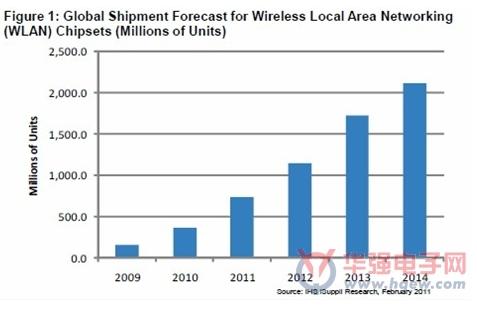 According to IHS iSuppli's research, the Wi-Fi market is expected to double in 2011, as Wi-Fi becomes an essential feature of many electronic products. It is estimated that WLAN chipset shipments this year will reach 738.9 million, which is an increase of 101.5% from the 366.8 million in 2010. These chipsets are used in various types of electronic products to enable consumers to share content. It is expected that its shipments will exceed 1 billion in the next year and more than 2 billion in 2014, as shown in Figure 1.
According to IHS iSuppli's research, the Wi-Fi market is expected to double in 2011, as Wi-Fi becomes an essential feature of many electronic products. It is estimated that WLAN chipset shipments this year will reach 738.9 million, which is an increase of 101.5% from the 366.8 million in 2010. These chipsets are used in various types of electronic products to enable consumers to share content. It is expected that its shipments will exceed 1 billion in the next year and more than 2 billion in 2014, as shown in Figure 1. The WLAN chipset has two forms of independence and embedding.
For independent WLAN chipsets, total shipments of independent customer access chipsets, access point/bridged router devices, and other Wi-Fi embedded devices reached 366 million in 2010, a 135% increase over 2009.
As for the second type of embedded solution, the connectivity WLAN chipset has penetrated into a variety of electronic products, including laptops, mobile phones, tablet PCs, high-definition televisions, portable media players, printers, cameras, camcorders, and DVDs. And Blu-ray players, game consoles, personal navigation devices and high-end car audio bodies.
The WLAN chipset is based on the Wi-Fi standard called 802.11n, and other connection technologies are increasingly entering the daily life of consumers. For example, a wireless personal area network (WPAN) dominates disparate technologies such as Bluetooth and short-range communications. Both of these technologies use radio waves to transmit and exchange data between devices that are closer together, thereby enhancing their mobility and ease of use.
Another connection technology is Zigbee, which is struggling to enter home automation, smart utility network monitoring applications for civil and commercial buildings. The company hopes Zigbee will find more applications in heating, cooling, and lighting applications in living areas, as well as monitoring of utility facilities such as gas, water, and electricity.
IHS believes that as Wi-Fi gradually becomes the standard wireless network interface for countless devices, the inherently easy interconnection capabilities of the technology will create conditions for more consumer electronics devices, enabling seamless connectivity and networking.
LED Underground Lights,Cob LED Underground Light,Underground Light Fixtures
LED Floodlight LED Street Light Co., Ltd. , http://www.ledelamp.com